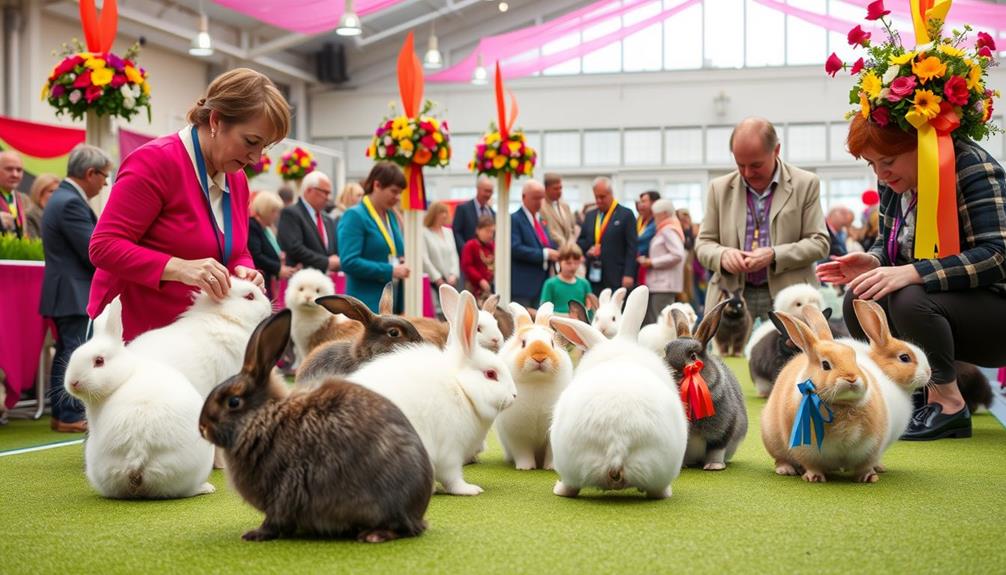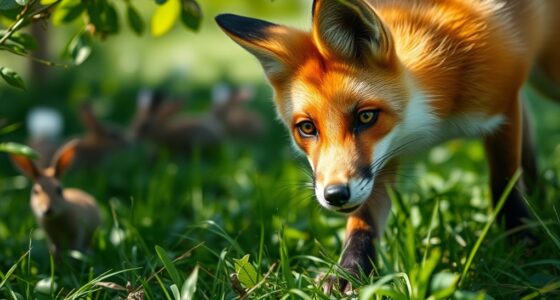When it comes to rabbit show competitions, judges focus on how well your rabbit meets breed standards. They assess physical traits like size, shape, and coat quality. Grooming plays a key role too, as a well-groomed rabbit presents its best features. Judges also consider your rabbit's health and overall vibrancy. Keep in mind that performance can vary based on whether it's a junior or senior category. Good sportsmanship and professionalism are essential for a positive experience. Knowing what judges look for can boost your chances, so stick around to discover more tips for success in the show ring!
Key Takeaways
- Judges evaluate rabbits based on breed-specific "Standard of Perfection," awarding points for ideal physical characteristics and adherence to breed traits.
- Grooming and presentation are crucial; clean, well-groomed rabbits showcase health and confidence, positively influencing judges' impressions.
- Nutrition and overall health significantly impact a rabbit's vibrancy, which judges appreciate during evaluations.
- Competitions are divided into junior and senior categories to ensure fairness in scoring and evaluation.
- Engaging with judges and peers enhances understanding of breed standards and fosters improvements in breeding and presentation techniques.
Judging Criteria Overview
When it comes to judging rabbit show competitions, understanding the criteria can make all the difference. Judges evaluate rabbits based on the breed's "Standard of Perfection," focusing on specific physical characteristics that define each breed.
You'll notice that each rabbit is compared to an ideal physical description, with points awarded for how closely they meet these breed standards. Additionally, just like dogs, rabbits also have distinct traits that judges look for, which can include aspects such as coat texture and color patterns. For insights on how to enhance your pet's appearance, check out dog grooming tips.
The judging process includes junior and senior categories, allowing for competition among different age groups. This structure guarantees that you're not only competing against rabbits of varying breeds but also against others of similar ages, which can be vital for fair evaluation.
At the end of the day, the judges' opinion plays a significant role in determining placements. Performance can vary based on individual judge preferences, as some may favor specific types or characteristics within the breeds they evaluate.
Ultimately, the process culminates in the selection of the Best in Show, where the top animals from each breed are compared and judged against one another. Understanding these criteria will help you prepare your rabbit for success in the competition ring.
Evaluating Rabbit Breeds
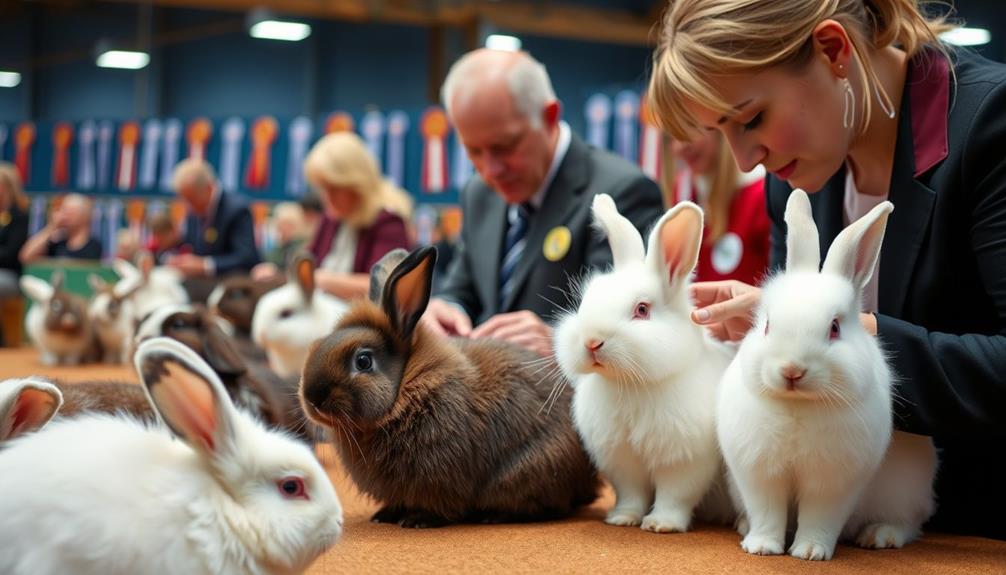
When evaluating rabbit breeds, it's important to understand the breed standards that define ideal characteristics.
Familiarizing yourself with the judging criteria is vital, as they guide how points are awarded based on each rabbit's traits.
Additionally, considering aspects like nutrition and overall health can contribute to a rabbit's performance in competitions, underscoring the significance of a healthy lifestyle for best results.
Breed Standards Overview
Evaluating rabbit breeds in competitions hinges on the breed's Standard of Perfection, which dictates the ideal physical traits for each breed. Judges assess these traits, including size, shape, coat texture, and color, to determine how well each rabbit aligns with its breed standards. Each breed has specific attributes that are essential for scoring, with a maximum of 100 points available.
Here's a breakdown of common breed attributes:
| Breed | Key Attributes | Points Allocation |
|---|---|---|
| Holland Lop | Compact body, short ears | Size: 20, Shape: 30 |
| Netherland Dwarf | Round head, short legs | Size: 25, Shape: 25 |
| Mini Rex | Plush coat, muscular build | Coat: 20, Shape: 30 |
| Angora | Long fur, round body | Coat: 30, Size: 20 |
| Lionhead | Mane-like fur, compact size | Coat: 25, Shape: 25 |
During competitions, judges differentiate between junior and senior categories to guarantee fairness. After evaluating the top contenders from each breed, they determine the Best in Show, showcasing rabbits that exemplify their breed's standards best.
Judging Criteria Explained
Rabbit competitions rely heavily on the breed's Standard of Perfection, but understanding how judges assess each entry is just as important. Judges evaluate rabbits against this standard, which outlines the ideal physical description and traits for each breed. They categorize entries into junior and senior classes, ensuring a fair comparison among rabbits of similar ages.
Awareness of the judging process can greatly enhance your preparation, much like recognizing the impact of narcissistic abuse in relationships can aid in recovery. As you prepare your rabbits for competition, keep in mind that judging can include a degree of subjectivity. Different judges may have varying preferences for specific types or characteristics, influencing their decisions.
Judges focus heavily on the overall quality and condition of the rabbits, emphasizing health, grooming, and adherence to breed standards.
Ultimately, the Best in Show award is given to the rabbits that exemplify the established standards best, often drawn from the top animals in each breed category. By adhering to the guidelines set by the Rabbit Breeders Association and understanding these judging criteria, you can enhance your chances of success in the competition.
This knowledge not only helps you present your rabbits effectively but also deepens your appreciation for the breed standards that guide the judging process.
Common Breed Characteristics
Understanding common breed characteristics is essential for anyone involved in rabbit competitions. Each rabbit breed has specific traits outlined in the ARBA's "Standard of Perfection" that judges use as a guideline during evaluations. Familiarizing yourself with these characteristics will help you better prepare for competition, much like how investors benefit from diversification of retirement portfolios to reduce risk exposure.
Here are some key aspects judges look for in rabbit breeds:
- Size: Different breeds have distinct weight and height requirements, which can greatly affect scoring.
- Coat Texture: The quality and feel of a rabbit's fur can vary greatly, influencing its appeal and adherence to breed standards.
- Color Patterns: Unique color combinations are often celebrated, but they must align with the breed's specific standards.
- Ear Shape and Body Type: These are critical features that vary by breed. For example, Holland Lops are characterized by their lopped ears, while English Angoras boast long, woolly fur.
Judges assess rabbits in both junior and senior categories, ensuring a fair comparison based on age and development.
Importance of Grooming

Grooming is essential for presenting your rabbit at shows, as a clean and natural look can greatly influence judges' impressions. Proper grooming techniques not only enhance your rabbit's appearance but also promote its health. Incorporating natural elements into your grooming routine, similar to the modern farmhouse decor trends, can create a holistic approach that benefits both you and your rabbit.
Regular grooming allows you to inspect the coat and skin for any potential issues or parasites, ensuring your rabbit is in top condition.
It's important to note that judges are trained to identify any grooming alterations, like nail polish or chalk, which are strictly prohibited. Such practices can lead to disqualification, so it's vital to stick to natural grooming methods. Observing successful exhibitors can provide valuable insights into effective grooming techniques that can improve your presentation skills.
Consistent grooming practices contribute to your rabbit's overall well-being, making it more comfortable and confident during competitions. A well-groomed rabbit isn't only visually appealing but also reflects your dedication and care as an exhibitor.
Presentation Techniques
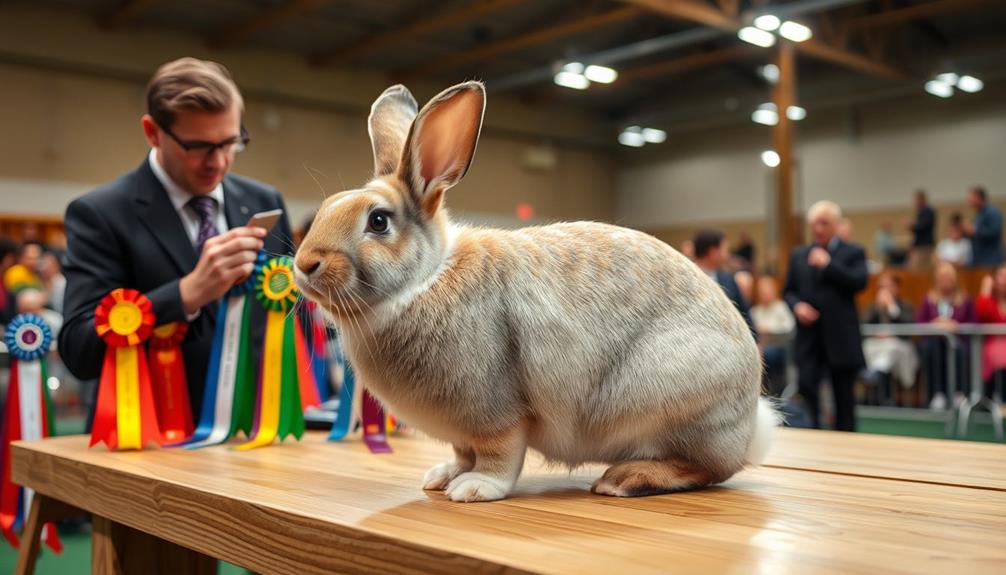
After your rabbit is groomed to perfection, the next step is to focus on presentation techniques that will showcase its best features. Judges from the Rabbit Breeders Association emphasize a clean, natural appearance, so avoid any grooming alterations like nail polish or chalk—these can get your rabbit disqualified.
Instead, aim to enhance your rabbit's qualities through effective presentation. It's important to ascertain that your rabbit's diet is healthy and appropriate, as a well-nourished rabbit will appear more vibrant and lively, which can positively impact its presentation in the ring. Look into vegan alternatives for feeding if you're pondering a cruelty-free approach to your rabbit's diet.
Here are four techniques to reflect on:
- Calm Handling: Always handle your rabbit gently. This reduces stress, making your rabbit appear more composed and confident in the judging ring.
- Highlight Breed Standards: Familiarize yourself with the ARBA's "Standards of Perfection" for your rabbit's breed. Present your rabbit in a way that emphasizes features aligned with these standards.
- Observe Others: Watch fellow exhibitors to learn successful grooming and presentation practices. You might pick up valuable tips that enhance your approach.
- Practice: Regularly practice your presentation techniques. The more comfortable you and your rabbit are, the better you'll perform during competitions.
Implementing these techniques can appreciably increase your rabbit's competitiveness in shows.
Competition Environment
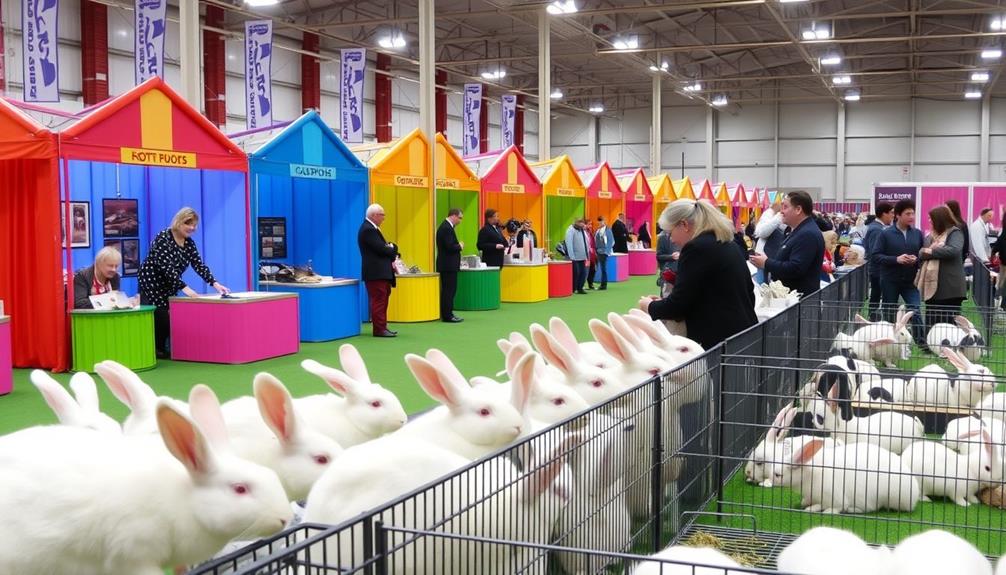
Maneuvering the competition environment can be both exciting and challenging for rabbit exhibitors. Rabbit shows vary widely, from local events that feel like friendly gatherings to national competitions where the stakes are higher. The American Rabbit Breeders Association (ARBA) sets the judging standards, ensuring each rabbit meets breed-specific criteria.
In this competitive atmosphere, rare breeds can shine due to fewer entries, making it easier to stand out. Judges meticulously assess the top animals from each breed for Best in Show, recognizing only the highest quality rabbits.
Here's a quick breakdown of competition environments:
| Competition Level | Atmosphere | Entry Quality |
|---|---|---|
| Local | Friendly | Generally lower |
| Regional | Competitive | Moderate quality |
| National | Intense | High-quality entries |
Networking with other exhibitors is also a key aspect of the competition environment. It fosters a sense of community, allowing you to share knowledge and experiences with fellow rabbit breeders and fanciers. Embrace this opportunity to learn and grow in your rabbit show journey!
Exhibitor Etiquette
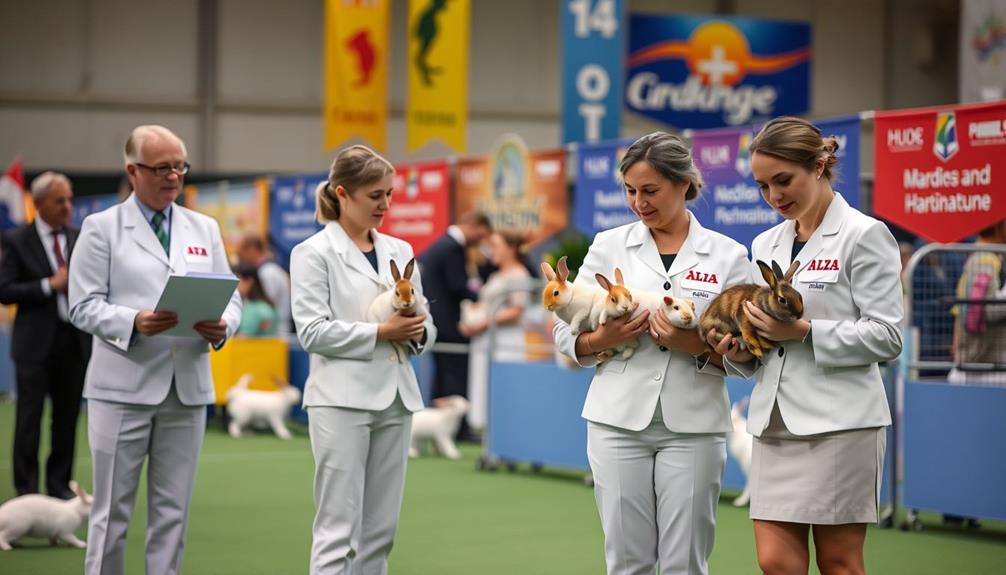
When you participate in rabbit shows, sportsmanship and respect are key to creating a positive environment.
Engaging in reviving old friendships is similar to building camaraderie among exhibitors; both require genuine effort and appreciation for others.
Make sure to congratulate winners and thank judges after evaluations to foster goodwill among exhibitors.
Sportsmanship and Respect
At rabbit shows, demonstrating sportsmanship and respect is essential for creating a positive experience for everyone involved.
Additionally, maintaining a healthy lifestyle through practices like stress management techniques can aid in fostering a calm and respectful atmosphere. You play a vital role in fostering a respectful atmosphere that encourages healthy competition.
Here are some key practices to keep in mind:
- Congratulate Winners: Always take a moment to congratulate fellow exhibitors who win awards. It shows good sportsmanship and builds camaraderie among participants.
- Thank the Judges: After evaluations, thank the judges for their time and expertise. This simple gesture acknowledges their efforts and promotes mutual respect.
- Be Professional: Avoid drawing attention to your own animals during evaluations. This maintains the integrity of the judging process and reflects your respect for the judges' decisions.
- Listen to Feedback: Embrace any feedback from judges. Not only does this enhance your learning, but it also demonstrates your respect for their authority and knowledge.
Professional Conduct Expectations
In order to create a respectful and enjoyable environment at rabbit shows, exhibitors must adhere to specific professional conduct expectations. Exhibitors should always demonstrate good sportsmanship by congratulating winners and thanking judges after evaluations. This fosters a positive atmosphere, which is essential for everyone involved.
It's important to maintain professionalism; avoid making negative remarks about competitors, as this guarantees a respectful competition. Additionally, just as in astrology and attractiveness, where personal traits can influence perceptions, maintaining a positive demeanor can enhance how you're viewed in the competition.
During judging, refrain from drawing attention to your own animals, allowing judges to make unbiased evaluations based solely on merit. Listening to judges' feedback is an invaluable learning opportunity that can enhance your understanding of breed standards and improve your future breeding practices.
You should also observe and learn from your peers, as sharing insights and techniques can elevate grooming and presentation standards within the community.
The Rabbit Breeders Association emphasizes these principles to promote integrity and respect among exhibitors. By following these professional conduct expectations, you contribute to a successful and enjoyable experience for everyone involved in rabbit shows.
Learning From Judges
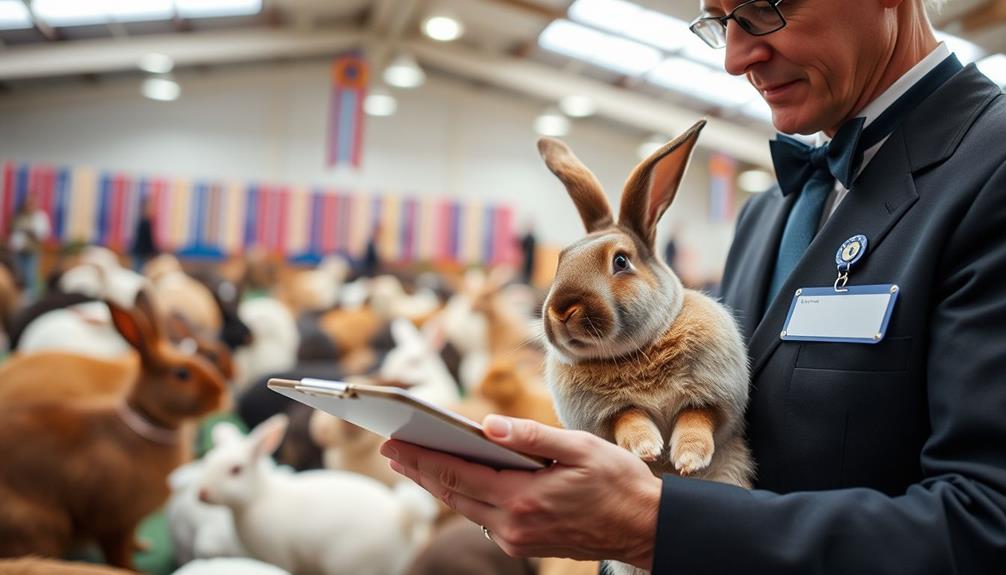
Learning from judges can truly elevate your rabbit show experience. When you engage with judges and absorb their insights, you gain valuable information that can refine your breeding practices.
Understanding the importance of quality assurance in your breeding methods is essential to achieving high standards, much like successful SQA engineers focus on key traits of successful SQA engineers to guarantee quality outcomes.
Here are four key ways to maximize your learning:
- Understand the Standards: Judges evaluate rabbits based on the breed's Standard of Perfection. Familiarize yourself with these standards to know what traits to prioritize in your breeding.
- Seek Feedback: After evaluations, don't hesitate to ask judges for their feedback. Their observations can highlight areas where you can improve, whether it's in grooming or overall presentation.
- Observe the Process: Watch how judges assess various aspects of the rabbits during competitions. This observation helps you understand their criteria and enhances your skills in preparing your rabbits for show.
- Network and Share: Engage with other exhibitors and judges after the show. This networking can lead to discussions that deepen your understanding of the Rabbit Breeders Association's standards and successful show strategies.
Resources for Success
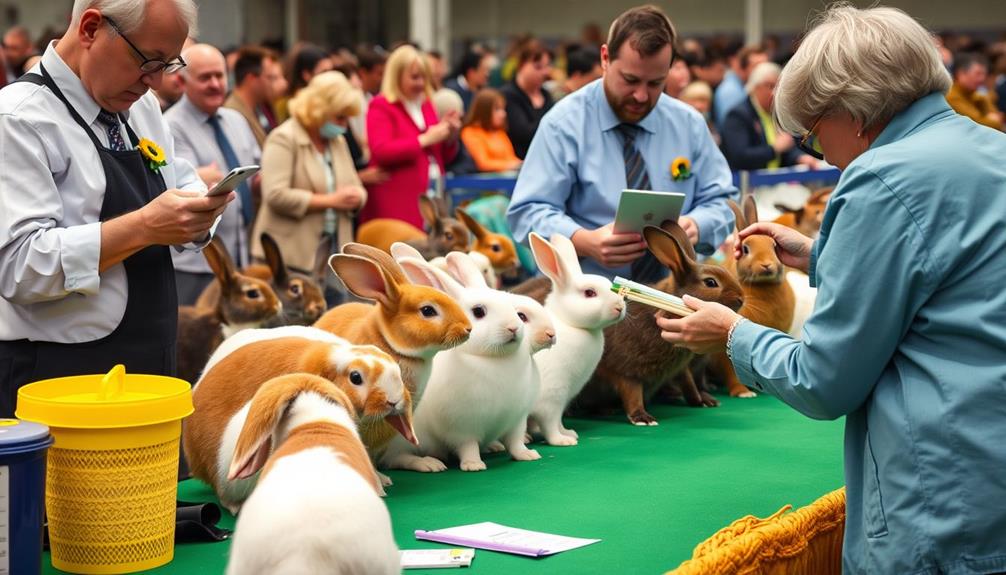
Accessing the right resources can greatly boost your success in rabbit show competitions. The American Rabbit Breeders Association (ARBA) offers a wealth of educational materials, including the essential guidebook, "Raising Better Rabbits & Cavies." This resource can help you refine your breeding and showing techniques, ensuring you're well-prepared for competition.
Additionally, the ARBA Library in Knox, Pennsylvania, boasts over 10,000 items focused on domestic rabbits. This extensive collection is perfect for in-depth research and gaining insights into best practices. It's a treasure trove for anyone serious about improving their skills.
Understanding the ARBA's standardized judging system, based on the "Standard of Perfection," is vital. This system provides clear criteria for judges, so knowing these standards helps you present your rabbits more effectively.
Moreover, take advantage of the ongoing judges' education program, which keeps judges informed about breed standards. This knowledge directly impacts the competition's quality and your preparation.
Lastly, don't underestimate the power of networking at rabbit shows. Connecting with experienced exhibitors can provide valuable insights and tips to enhance your showing practices. Use these resources to set yourself up for success!
Frequently Asked Questions
What Do Judges Look for in Rabbit Shows?
When judging rabbit shows, you'll notice judges look for specific breed traits, overall health, and natural presentation. They prioritize adherence to breed standards and may disqualify rabbits that don't meet grooming expectations or show alterations.
What Are the Disqualifications for Show Rabbits?
Disqualifications for show rabbits are like hidden traps; any signs of illness, improper grooming, or failure to meet breed standards can cost you. Temperament matters too—aggression or timidity can lead to elimination.
What Do You Look for in a Show Rabbit?
When you're evaluating a show rabbit, you should focus on its breed standards, body type, coat quality, and overall health. Remember, a clean, natural appearance enhances its chances, so grooming is key before the show.
How Are Market Rabbits Judged?
When judging market rabbits, you'll focus on meat quality, weight, and conformation. Uniformity in size, breed suitability, and fur cleanliness matter too. Make sure your rabbits meet weight categories for top placements.
Conclusion
In rabbit show competitions, you might think that winning is all about the breed, but that's not the whole story. It's the combination of grooming, presentation, and how you interact with judges that truly makes a difference. If you invest time in understanding what judges value, you'll not only improve your chances of success but also deepen your bond with your rabbit. So, are you ready to elevate your competition game and discover the secrets of the judges?
